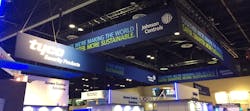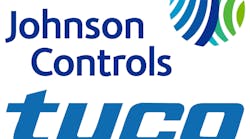ORLANDO – The newly merged Johnson Controls and Tyco began operations the week before the ASIS show, which gave the new company a chance to officially unveil its new branding and message to the security industry in Orlando.
Along with the integration of the extensive portfolio of technologies from Tyco Security Products, the merger also brings together two of the top 10 largest global security integration businesses (Johnson Controls and Tyco Integrated Security), to form the undisputed largest security integrator in the world.
At ASIS, the combination of the companies was the focus — although after my exclusive show-floor interview with Joe Oliveri, vice president and general manager of Tyco Integrated Security, it became clear that the new Johnson Controls would still feature a lot of the “old” Tyco branding.
“Tyco’s the brand — that’s what people know us as,” Oliveri said. “Take SimplexGrinnell as an example: People know that brand, and it is worth something in the industry. You lose that if you take away that brand.”
In addition to SimplexGrinnell and Tyco Integrated Security, those brands span a wide range of technologies that security industry users and integrators know well, including American Dynamics, Software House, Exacq, Kantech, DSC, Proximex, Visonic, CEM Systems, Elpas and others.
“For now, those brands are staying, and that’s how we are going to market,” Oliveri said. “That is also true on the integration side. When we split from ADT several years ago, we spent a lot of money on branding, from print to television, so we’ve built up some capital and we want to keep it. That may change in a year or two as we evaluate the branding, but for now, there’s no (integration branding) changes.”
Interestingly, Tyco Integrated Security and Oliveri never really viewed the Johnson Control integration business as a major competitor, saying that both companies tended to play in their own spaces.
“If you look at where Johnson Controls plays really well, it is in the bundled space where they go after large projects and putting everything together with a general contractor,” Oliveri said. “Tyco Integrated Security today really doesn’t play in that space — most of our work is negotiated design-build. So when you look at what they do as compared to what we do, it truly is complementary. Thinking back in the past, we would maybe be competing with (Johnson Controls) 10 percent of the time on bids, so there’s not a lot of crossover. That’s why (the merger) is a really good fit. How we decide to leverage all those resources is still up for discussion, but the key will be how we leverage all of our strengths and put them together to grow.”
Oliveri’s message to the industry is simple: “The combination of Johnson Controls and Tyco offers the security end-user community access to more capabilities and products,” Oliveri said. “It brings together the complementary strengths of two great companies — Tyco’s fire, security, life safety and services business with Johnson Controls’ building products, technology, integrated solutions and energy storage — to better serve large institutions, commercial buildings, retail, industrial, small business and residential.”
Read more on the merger at www.securityinfowatch.com/12255306.
Paul Rothman is Editor in Chief of Security Dealer & Integrator (SD&I) magazine. Access the current issue and archives at www.secdealer.com.





